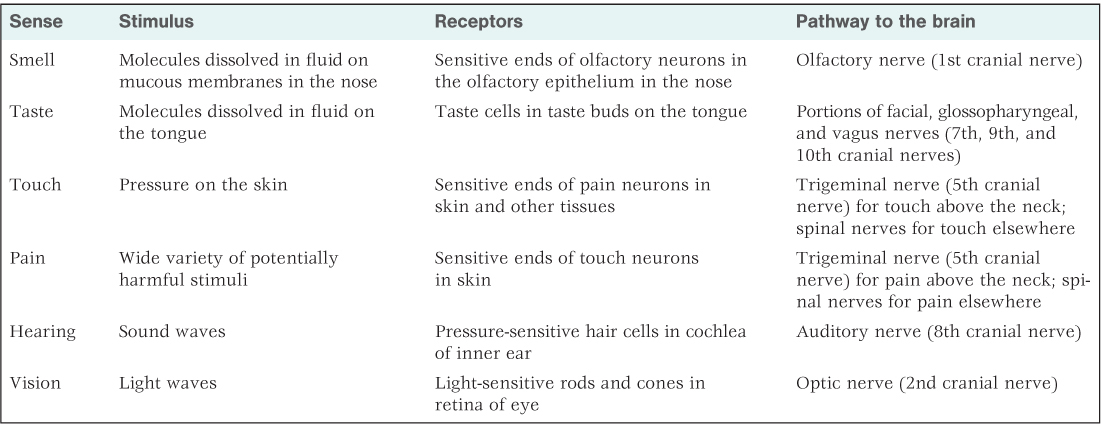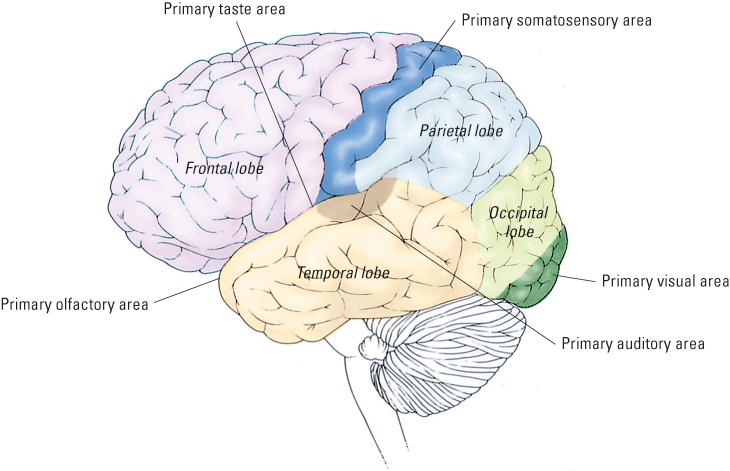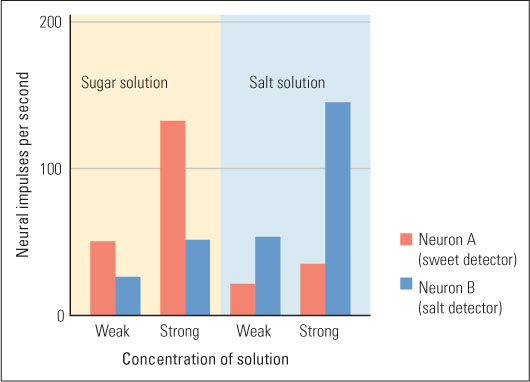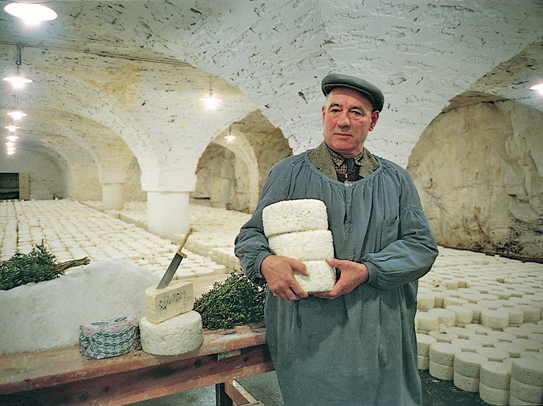7.1 Overview of Sensory Processes
1
How can the process of sensation be described as a chain of three different kinds of events?
Most broadly, the process of sensation can be diagrammed as follows:
physical stimulus → physiological response → sensory experience
We have here three classes of events, each of which is entirely different from the others: (1) The physical stimulus is the matter or energy of the physical world that impinges on sense organs; (2) the physiological response is the pattern of chemical and electrical activity that occurs in sense organs, nerves, and the brain as a result of the stimulus; and (3) the sensory experience is the subjective, psychological sensation or perception—the taste, sound, or sight, for instance—experienced by the individual whose sense organs have been stimulated. The sensory experience generally tells us something about the physical stimulus, but it is a very different thing from the physical stimulus. In sipping a cup of coffee, we encounter molecules of caffeine on our tongue, and we experience a bitter taste. The bitterness is not a chemical property of the caffeine molecules; it exists only in our sensory experience triggered by the molecules. Electromagnetic energy of a certain wavelength enters our eyes, and we experience the dark brown color of coffee. The brown color is not a property of the electromagnetic energy but exists only in our sensory experience.
Sensory psychologists are interested in identifying lawful relationships among the three just-described classes of events. Here, before discussing particular senses separately, let’s consider some general principles that apply to all sensory systems.
Each Sensory System Has Distinct Receptors and Neural Pathways
Ever since Aristotle, people have spoken of the five senses, identifying them as smell, taste, touch, hearing, and vision. Actually, humans have more than five senses, and any attempt to tally them up to an exact number is arbitrary, because what one person thinks of as one sense may be thought of as two or more by another. For example, our skin is sensitive not just to touch but also to temperature and pain, neither of which is included in Aristotle’s five. Other senses omitted by Aristotle have to do with body position and the body’s internal environment. We have a sense of balance, mediated by a mechanism in the inner ear, and a sense of limb position and movement, mediated by receptors in muscles and joints. Each sense has distinct sensory receptors and neural pathways to and within the brain (Hendry & Hsiao, 2012a).
247
Sensory receptors are specialized structures that respond to physical stimuli by producing electrical changes that can initiate neural impulses in sensory neurons. Sensory neurons (described and illustrated in Chapter 5) are specialized neurons that carry information from sensory receptors into the central nervous system. For some senses, receptors are simply the sensitive ends of sensory neurons; for others, they are separate cells that form synapses upon sensory neurons. For some senses, receptors all exist in a specific, localized sensory organ, such as the ear, eye, or nose; for others, they exist in a wide variety of locations. Pain receptors, for example, exist not just throughout the skin but also in muscles, tendons, joints, and many other places. The stimuli, receptors, and peripheral nerves involved in the most thoroughly studied senses are listed in Table 7.1.
Stimuli, receptors, and the pathways to the brain for various senses

Regardless of whether they come from one location or many, the neurons for any given sense lead to pathways in the central nervous system that are unique to that sense. These pathways send their messages to many different parts of the brain, including specific sensory areas of the cerebral cortex—including areas devoted to vision, hearing, and touch, for example (see Figure 7.1). Although brain structures below the cortex can organize unconscious behavioral reactions to sensory stimuli, conscious sensory experiences depend on activity within the cerebral cortex.

Every sensation that you experience consciously is a product, ultimately, of some pattern of activity within a sensory area of your cerebral cortex. You see light because light receptors in your eyes are connected to visual areas of your cortex, and you hear sound because sound receptors in your ears are connected to auditory areas of your cortex. If we could somehow rewire those connections, sending your optic nerves to your auditory brain areas and your auditory nerves to your visual brain areas, you would hear light and see sound. When you bump the back of your head, you may “see stars,” because the bump artificially activates neurons in visual areas of your brain.
248
Sensory Systems Preserve Information About Stimulus Quantity and Quality
2
In general, how do physical stimuli produce action potentials in sensory neurons?
For senses to be useful, they must preserve—in the patterns of neural activity they produce—relevant information about the physical stimuli to which they are responding. That preservation of information is referred to as sensory coding.
Every form of energy can vary along at least two dimensions—a quantitative dimension and a qualitative one. The quantitative variation has to do with the amount or intensity of energy. A sound or light can be weak or strong; molecules stimulating taste or smell can be dilute or highly concentrated. The qualitative variation has to do with the precise kind of energy. Lights of different wavelengths (which we perceive as different colors) are considered to be qualitatively different, as are sounds of different frequencies (which we perceive as different pitches), as are different chemicals (which we perceive as different smells or tastes). For each of our senses, transduction (the process by which a receptor cell produces an electrical change in response to physical stimulation) occurs in such a way that information about the quantity and quality of the stimulus is preserved in the pattern of action potentials sent to the brain.
3
In general, how do sensory systems code information about the amount and kind of stimulus energy?
Coding of stimulus quantity results from the fact that stronger stimuli produce larger receptor potentials, which in turn produce faster rates of action potentials in sensory neurons. The brain interprets a fast rate of action potentials as a strong stimulus and a slow rate as a weak stimulus.
In contrast, the coding of stimulus quality occurs because qualitatively different stimuli optimally activate different sets of neurons. Different receptors within any given sensory tissue are tuned to respond best to somewhat different forms of energy. In the eye, for example, three different kinds of receptor cells, each most sensitive to a different range of wavelengths of light, provide the basis for color vision. In the ear, different receptors are most sensitive to different sound frequencies. And in the nose and mouth, different receptors are most sensitive to different kinds of molecules. Thus, in general, qualitative variations are coded as different ratios of activity in sensory neurons coming from different sets of receptors. For an illustration of how quantitative and qualitative information about a stimulus can be independently coded for the sense of taste, see Figure 7.2. The same principle applies to other senses, as you will discover later in this chapter.

249
Sensory Systems Respond to Changes More Than to Steady States
Our senses are designed to alert us to changes in our sensory environment and to be relatively oblivious to steady states. When you first put on your wristwatch, you feel the pressure on your skin, but later you don’t. When you first wade into a lake, the water may seem terribly cold, but later only slightly cool. When you first enter a chemistry lab, the odor may seem overwhelming, but later you hardly notice it. The change in sensitivity that occurs when a given set of sensory receptors and neurons is either strongly stimulated or relatively unstimulated for a length of time is called sensory adaptation. In general, when the amount of stimulation of a sensory system increases for a period of time, the sensory system adapts by becoming less sensitive than it was before; and when the amount of stimulation decreases, the sensory system adapts by becoming more sensitive than it was before.
4
What is the value of sensory adaptation? How can you demonstrate that adaptation can occur in neurons in the brain, not just in receptors?
In many cases, sensory adaptation is mediated by the receptor cells themselves. If a stimulus remains for a period of time, the receptor potential and rate of action potentials are at first great, but over time they become much reduced, resulting in reduced sensation. In other cases, however, adaptation is mediated at least partly by changes further inward in the central nervous system.

SECTION REVIEW
Sensory experiences result from physiological responses to physical stimuli.
Receptors and Pathways
- Sensory receptors respond to physical stimuli with electrical changes, a process called transduction.
- Those electrical changes, called receptor potentials, can trigger action potentials in sensory neurons.
- Activity in a specific sensory area of the cortex (such as visual) produces a corresponding type of sensory experience (such as sight).
Sensory Coding
- Information about physical stimuli is coded in the patterns of neural activity induced by the stimuli.
- Stronger stimuli produce larger receptor potentials and faster rates of firing in sensory neurons.
- Qualitatively different stimuli produce different ratios of activity across different sets of receptors and sensory neurons.
Sensory Adaptation
- In general, continuous stimulation reduces the responsiveness of a sensory system and lack of stimulation increases its responsiveness.
- The result of this is that senses are much more responsive to changing than to unchanging stimulation.